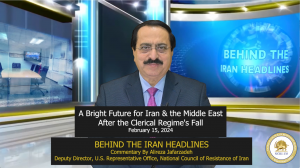
 NCRI President-elect Maryam Rajavi’s 10-Point Plan for the Future of Iran rejects the velayat-e faqih...
NCRI President-elect Maryam Rajavi’s 10-Point Plan for the Future of Iran rejects the velayat-e faqih... The National Council of Resistance of Iran (NCRI) provides a unified platform for the Iranian people to challenge the regime and advocate for democratic change.
— Alireza Jafarzadeh, Deputy Director of NCRI’s Washington Office
WASHINGTON, DC, UNITED STATES, February 15, 2024 /EINPresswire.com/ — The 1979 popular uprising against the Shah’s despotic rule marked the historic end of the monarchy as a system of governance in Iran. It culminated decades of patriotic struggle for freedom, justice, and democracy.
However, the leadership vacuum created by the Shah’s repression of intellectuals and nationalist forces allowed the clerics to hijack the revolution, ushering in a new era of theocratic despotism. The new dictatorship. i.e., theocracy perpetuated repression, censorship, and human rights abuses surpassing those of Shah’s regime. Exporting terrorism and warmongering became the cornerstones of the mullahs’ foreign policy.
Soon after, the People’s Mojahedin Organization of Iran (PMOI/MEK) emerged as the primary opposition force, garnering support from diverse segments of Iranian society. In 1981, with the MEK as its principal force, the National Council of Resistance of Iran (NCRI) was established. This coalition of pro-democracy opposition groups and personalities aimed to fill the leadership void and provide a unified platform for the Iranian people to challenge the regime and advocate for democratic change. (https://twitter.com/NCRIUS/status/1628786773450018817)
The impact of the NCRI’s unwavering rejection of the Shah’s monarchy and the mullahs’ theocracy was evidenced in the 2022 uprising, where the people across Iran chanted, “Down with the Oppressor; Be it the Shah or the Supreme Leader (Khamenei).” (https://twitter.com/NCRIUS/status/1611428490062225411)
Since 2017, the MEK’s Resistance Units have played a pivotal role in organizing and advancing anti-regime uprisings, a clear rejection of the regime’s sham “elections.”
The overthrow of the clerical regime would liberate Iran, establish democracy, and foster peace in the region.
As Lord David Alton, a member of the UK’s House of Commons, noted last month, “Our best allies and our partners for an effective strategy to counter the regime’s destructive role in the Middle East are the Iranian people and their organized resistance movement, led by Madam Rajavi,” referring to the president-elect of the NCRI, Mrs. Maryam Rajavi. (https://twitter.com/NCRIUS/status/1625167145549045760)
# # #
———————————————-
BACKGROUND
The National Council of Resistance of Iran (NCRI) is a democratic coalition of Iranian opposition organizations and personalities and was founded in Tehran, Iran, in July 1981, as the alternative to the clerical regime, a month after the onset of the nationwide resistance to overthrow the ruling dictatorship.
The NCRI is committed to the affirmation of the people’s sovereignty in a republic founded on universal suffrage and pluralism; gender equality; separation of religion and state and freedom of religions and faiths; freedom of thought, press, and association; support for peace in the Middle East; plan for the autonomy of Iranian nationalities and ethnicities; and the Universal Declaration of Human Rights, as embodied in Mrs. Maryam Rajavi’s 10-Point Plan for Future Iran.
The NCRI would serve as a provisional government led by its President-elect Mrs. Rajavi, and its primary responsibility will be to hold free and fair elections for a national and constituent assembly within six months to ensure the peaceful transition of power to the elected representatives of the Iranian people.
Iran’s largest, most organized opposition group, the People’s Mojahedin Organization of Iran (PMOI), also referred to as the MEK, is the principal member of the NCRI.
————————————————-
These materials are being distributed by the National Council of Resistance of Iran-U.S. Representative Office (NCRI-US). Additional information is on file with the Department of Justice, Washington, D.C.
For more information:
NCRI-US: https://www.ncrius.org/
Maryam Rajavi: https://www.maryam-rajavi.com/en/
NCRI: https://www.ncr-iran.org/en/news/
MEK: https://english.mojahedin.org/
NCRI-US
National Council of Resistance of Iran – US Rep. Office
+1 202-747-7847
email us here
Visit us on social media:
Facebook
Twitter
LinkedIn
Instagram
YouTube
![]()
Article originally published on www.einpresswire.com as Bright Prospects for Democracy in Iran and Peace in the Middle East After the Clerical Regime’s Fall
originally published at HUMAN RIGHTS - USA DAILY NEWS 24


